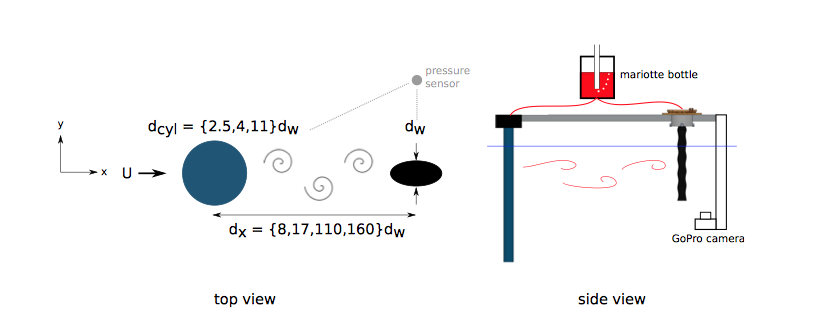Imagine if you had to track your lunch based on the disturbance it had caused in the air around it 30 seconds ago as detected by your beard. Obviously somewhat more difficult to imagine for women, but still, even the most hirsuite of gentlemen would have to admit that they might find themselves going hungry more often than not. Well, seals, male or female, don’t seem to find that sort of task very difficult at all.
 The question of how exactly they manage to accomplish this is one that has been on the minds of members of MIT’s Department of Mechanical Engineering. Heather Beem, a graduate of the PhD program, and her dissertation director Michael Triantafyllou have recently published the results of their research into the marvelous sensing abilities of the bewhiskered harbor seal in the Journal of Fluid Mechanics.
The question of how exactly they manage to accomplish this is one that has been on the minds of members of MIT’s Department of Mechanical Engineering. Heather Beem, a graduate of the PhD program, and her dissertation director Michael Triantafyllou have recently published the results of their research into the marvelous sensing abilities of the bewhiskered harbor seal in the Journal of Fluid Mechanics.
One of the qualities of these mysterious whiskers is that they are able both to remain still while the seal moves through water and to vibrate in response to the turbulence in the water caused by the movement of other bodies in the water. That is a pretty tall order. They are able to perform in this way because of their unique form; rather than being the straight, tubelike structures we had imagined, their form follows a perfect sine wave.
 Now, just in case you don’t keep the latest copy of this journal on your nightstand, let me explain how this relates to 3D printing. In order to closely study the way that this form affects their movement, Beem 3D printed a replica of a seal whisker but at a much larger scale. That ‘super-whisker’ was then tested in a 30 meter long tank of water while attached to a moving track. This sinusoidal form results in much smaller disturbances as it moves through water, effectively quieting the vibrational ‘noise’ that otherwise would be generated. Professor Triantafyllou explained:
Now, just in case you don’t keep the latest copy of this journal on your nightstand, let me explain how this relates to 3D printing. In order to closely study the way that this form affects their movement, Beem 3D printed a replica of a seal whisker but at a much larger scale. That ‘super-whisker’ was then tested in a 30 meter long tank of water while attached to a moving track. This sinusoidal form results in much smaller disturbances as it moves through water, effectively quieting the vibrational ‘noise’ that otherwise would be generated. Professor Triantafyllou explained:
“It’s like having the ability to stick your head out of a car window, and have there be no noise, so that your ears don’t ring: It’s a quieting effect.”
That was just one part of the equation, however. The other job of the whisker is to vibrate in response to turbulence caused by moving objects. Interestingly enough, the very properties of the whisker’s form that allowed it to move silently through the water are also what cause it to react strongly to the wake of external movement. In the 30 meter tank, the 3D printed whisker was moved along its track while a cylinder was moved ahead of the whisker’s path. As the eddies generated by the cylinder were passed through by the whisker, it began to vibrate at a matching frequency, something that would give a seal an idea of the direction, size, and shape of the object generating those eddies. Beem summed up the conclusions of this research:
“The geometry of the whisker allows for this phenomenon of being able to move very silently through the water if the water’s calm, and extract energy from the fish’s wake in order to vibrate a lot. Now we have an idea of how it’s possible that seals can find fish that they can’t see.”
 And for those of you who aren’t satisfied with just knowing something for its own sake, don’t worry, there may be practical applications for this knowledge.
And for those of you who aren’t satisfied with just knowing something for its own sake, don’t worry, there may be practical applications for this knowledge.
Professor Triantafyllou outlined one area in which this understanding could have an impact:
“We already have a few sensors that can detect velocity [for underwater vehicles], but now that we know better what they can do, we can use them to track sources of pollution and the like. By having several whiskers on a vehicle, like the seal, you can, for example, detect a faraway plume, and track it all the way to the end.”
Not too shabby. It may be time that we stop being so impressed with bees’ knees…and start giving a little more respect to seals’ whiskers. Let’s hear your thoughts on this research in the 3D Printed Seal Whisker forum thread on 3DPB.com.
Subscribe to Our Email Newsletter
Stay up-to-date on all the latest news from the 3D printing industry and receive information and offers from third party vendors.
Print Services
Upload your 3D Models and get them printed quickly and efficiently.
You May Also Like
The Dental Additive Manufacturing Market Could Nearly Double by 2033, According to AM Research
According to an AM Research report from 2024, the medical device industry, specifically in dentistry, prosthetics, and audiology, is expected to see significant growth as these segments continue to benefit from...
Heating Up: 3D Systems’ Scott Green Discusses 3D Printing’s Potential in the Data Center Industry
The relentless rise of NVIDIA, the steadily increasing pledges of major private and public investments in national infrastructure projects around the world, and the general cultural obsession with AI have...
AM Research Webinar Explores Continuum’s Sustainable Metal Additive Manufacturing Powders
Metal additive manufacturing (AM) powder supplier Continuum Powders is working to develop solutions that empower industries to reduce waste and optimize their resources. An independent life cycle assessment (LCA) of...
3D Printed Footwear Startup Koobz Lands $7.2M in Seed Round
California-based Koobz is focused on reshoring the U.S. footwear supply chain with advanced manufacturing processes, including 3D printing. The startup just announced that it has added $6 million to its...

































